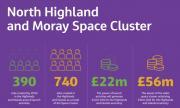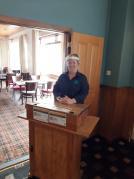
This site uses cookies, by continuing to use this site you accept the terms of our privacy policy
Feed 2.0 Loading...
Chief Executive Scottish Chambers Of Commerce Speech In Caithness
19th September 2006
Speech by Liz Cameron
Chief Executive
Scottish Chambers of Commerce
Caithness Chamber AGM, Park Hotel, Thurso
19 September 2006
Ladies & Gentlemen, good afternoon. First may I say how delighted I am to be here in Scotland's true North East? It is always uplifting to the spirit to leave the City behind and breathe the clear air, admire the stunning scenery and enjoy the warm welcome of the North of Scotland. I was going to say 'Highlands' but, somehow the term 'Highlands' doesn't quite work here in the unique landscape of Caithness.
I travel all over Scotland representing the interests of business, and I am very conscious that whilst to outsiders 'Scotland' might seem like a homogenous whole, to ourselves our population is as varied as our environment. I never yet heard an Orcadian say they were 'a Scot'. Meanwhile in Hawick, heartland of rugby and textiles, they still say 'a day out of Hawick is a day wasted'. (Yes they really do!) Perhaps this is one of the greatest challenges for businesses and their representatives in Scotland, both in terms of promoting what we do internationally, and in having bargaining clout with the politicians national and local, who can have so much influence over how policy affects our ability to build and sustain our communities through profitable trade - how do we unite for our common cause?
Our future does not lie in parochial attitudes - make no mistake business planning can suffer from NIMBY syndrome as much as householders! Nor does it lie in the over-concentration of power and influence in the Central belt. On a regional scale the same could be said of the Highlands. A successful Inverness can be an important driver for the Region. But not if that means a town like Thurso becomes marginalised and our quest to maintain and improve living standards for the rural hinterland, becomes secondary to the needs of urban centres. Of course the central belt, with 80% of Scotland's population is the key economic driver for the country as a whole, but if I left you this afternoon thinking that I felt I could swan up from Glasgow and give you the benefit of my wisdom as if I knew better than you what your area needs, I would have failed miserably. So much of Scotland's identity is shaped by the character and culture of the Highlands, that that alone (and it has strong economic benefits as I hope to show shortly) is a key reason why our peripheral areas are so important to the country as a whole. So in Caithness today we are in an area which is peripheral only in the sense of its geography. Spiritually it is as central as any part of our nation. With a population of some 28,000 Caithness has in the past and will in the future disproportionately influence what makes up the Scottish character and soul.
One of the most distinctive variations I notice travelling through Scotland, is the way that drystane dykes change from place to place. Evidence of varying geology and geography as profound and subtle as how the whisky flavours vary from place to place. Visitors cannot help but remark on the Caithness Flags. It is significant that when in 1912 Sir Edward Lutyens was commissioned to design New Delhi, the grand edifice of British architecture that was to replace Calcutta as the administrative centre of the British Raj in India, he specified Caithness Flags as the finest paving stone in the world. That global recognition of quality product and its durability are for me an important symbol of what together we can work to achieve for your economy. I have heard that the stone is noted for its fossil content. Well, here the image lets me down, because, whilst we must respect the past, it is clear we must let go of any fossils in our thinking if we are to create a successful future. And it's the future I want to talk with you about this afternoon.
I believe Chambers of Commerce, locally, both small and large, and nationally both at the level of Scotland (through my own organisation) and through British Chambers of Commerce based in London, are the single most effective means of delivering unity of support for what businesses need today. With over 9,000 member companies in Scotland, we represent a million working people and a turnover of tens of billions of pounds. The range of our members means we are the only organisation that truly represents the spectrum of Scottish businesses from sole traders to some of the world's largest corporations. I believe passionately that that 'industry' (in the original meaning of the word), is the basis of Scotland's wealth, not just in monetary terms, but our ability to deliver health, wealth and happiness to all our people by whatever means. It is a successful economy that funds healthcare, education and social development, through taxation. But we also need that economy to be continually renewing itself in a fast changing world, which means we develop our infrastructure to ensure we deliver successful business as the driver of the economy which enables social progress. Business today is global, or we aren't in business. So we have to offer infrastructure which enables us to compete on that level.
A great strength of our network of Chambers is that it is truly national, from east coast to west, from the north to the south, and up into the Highlands and Islands. So for me one aspect of strengthening your position here, is to look, not just to how we can better link you into the South, but how can we connect you into strategies and trading that benefits, Orkney, Shetland and Scandanavia. There are many times when in Edinburgh and Glasgow we gnash our teeth at London-centric policies and statements. Politicians and media are equally guilty. How frustrating must it be in the Highlands and Islands if we in Glasgow and Edinburgh - or Aberdeen or Inverness, do the same to you. It is no mistake that Orkney and Shetland each have a 'mainland' of their own, and they don't mean the bit we're standing on now. Scotland was governed from Orkney long before there were thrones in Stirling or Edinburgh. Which leads us into Scandanavia and the Baltic states newly acceded to the European Union. What huge potential there is in those markets. If a country like Iceland can sustain one of the highest standards of living in the world and produce companies like Baugur, now a serious player in UK and Danish retailing, why should we not do as well from a place like Caithness?
I was delighted to see that the Young Entrepreneur Factory conference which ran in Aviemore last week included participants from the project partner countries of Sweden, Iceland and Norway - a sure sign that the young people who attended to be encouraged and inspired to be tomorrow's entrepreneurs are doing so in a way that will be outward looking and continue to connect the Highlands to international thinking and markets. Whilst we're talking about young people, can I also applaud two notable Northern successes, Farr High School over in Bettyhill, for winning the Scottish Council for Development and Industry (SCDI) Highlands and Islands Young Engineers Club of the Year Award for their excellence in engineering, and Ross-shire young entrepreneur David Skea (20) for winning the Highland final of the 2006 Prince's Scottish Youth Business Trust (PSYBT) and Royal Bank of Scotland Business Awards for his two year old business in diver-caught shellfish, already servicing markets as far apart as London, Spain and Singapore.
Closer to home, may I also add my congratulations to Professor Iain Baikie and his team at KP technology, who collected the Highlands and Islands Award for Business Excellence in Research and Development, also from the SCDI. Their Kelvin Probe measurement system is building well as a product, and they have identified various systems to extend the product line, including corrosion in iron and steel, studies of semiconductors and electronic devices, and biomaterials. Perhaps we can get one fitted to the Forth Bridge to expedite saving transport corridors to the North of Scotland!
The reason for raising these individuals and companies at this time is because I believe it is important to recognise that Caithness and indeed all of rural Scotland can and does host innovative companies building new businesses where others go into abeyance. We know that the 2,000 jobs at Dounreay, on which this region is so dependant, have but a few years left to run. Whilst the cost and work of decommissioning the site will sustain employment for another thirty years, and deliver some billions of pounds into our economy, we are facing perhaps 1500 of those jobs evaporating in the next six years. It may be unrealistic to seek one employer to fill that void.
We will probably need half a dozen successful new ventures of significant size to tackle the core of that challenge. In the nature of things a small flotilla of sole traders will probably make up the balance. The sort of company for which Chambers of Commerce have so often been a lifeline. I know that with some 1250 businesses currently on the Caithness business directory you have the skills and resilience to champion the role of business in keeping people working and living in your community, even when so many jobs are on the line.
The decline of opportunities in fishery and agriculture, the first through EU restrictions and the second through mechanisation and market pressures, mean that the traditional sources of work in Caithness are not the future. Disappointments with the scaling back of Norfrost and Grampian Records and the closure of Caithness Glass could send us into spiral of disappointment. Or we could, as the old road safety advert said "Stop, look and listen" for the way forward. What do we need to do to build this local economy? With regular air services from Wick to Edinburgh and Aberdeen we have a lifeline. As a former RAF base you have the advantage of a huge runway. But what can we do about the vagaries of the weather, which so often impinge on the service? It seems to me that we have a strong case for lobbying for the technology to make all weather flying a possibility. That is the sort of infrastructure development we can press on the Scottish Executive.
Another point in case is the road and rail systems. With significant challenges to swift transport on either, conventional wisdom says we lack the cost benefit analyses to justify investment in these areas. Not enough traffic. Perhaps we can back measures to alleviate the situation. Within our evidence on the National Transport Strategy we have argued that issues of peripherality be given added weight to arguments for investment in remote locations which cannot be justified by traffic levels alone. Also we must consider that inadequate infrastructure is itself an artificial suppressant to those levels. How much more attractive would a bridge at Dornoch make that journey? A four hour train ride to Inverness is a significant barrier to connectivity and therefore to business. It is not, however, an inevitability. Rationalisation of remote crossings, improvement to passing places and adequate rolling stock are not rocket science. Better connectivity would lead to a boom in tourism, for example. Whilst Skibo Castle shows how it can be done for the few, I'm sure it can also be done for the many. Natural assets such as the Flow Country, a world class site in terms of bird-watching, are there to be capitalised on.
We must also ask to what extent Caithness can benefit from the general strengths of the Highland economy? If we lament the closure of Dounreay (at least in employment terms) might we not look to renewables as a key way forward? Leith based Ocean Power's Pelamis wave farm system, trialled in Orkney has so far only found favour in Portugal. I understand we have enough wave and current power to run the electricity for the whole of Scotland, here in the Pentland Firth. Whilst renewables can also raise hackles if they are perceived as being in conflict with the amenity value of our landscape this is surely an area of great opportunity for your region that has a rich supply, of, if nothing else, weather. And if there are objections about transmission distances and infrastructure, might we not look at local applications of abundant energy, such as high energy consumption manufacturing, or radical new transport fuels such as hydrogen, generated from seawater? That example of KP's outstanding R&D is the kind of mindset we need to bring forward fresh ideas like these, and I will continue to lobby for better Scottish Executive support for R&D. I am sure that the University of the Highlands and Islands will be a significant partner in discovering and building these future initiatives.
Another great challenge I believe you face is how to get the astronomic growth of Inverness to work in your favour. Do the Regional Council and HIE work to share those benefits into the edges of the Region? Do you ask them to? There may be similar opportunities in Aberdeen's burgeoning oil economy to find devolved strands of the whole which can bring new life to this area. With sixty thousand people working in the call centre industry, here is another growth area which could do well. We know that customers are revolting against off-shore services and that sensible businesses are keeping service standards up by keeping or bringing home these centres. Whilst there are frequent reports of individual contracts ending, there are equal numbers of new ones starting. We know that Scottish voices are regarded as 'reliable and helpful.' Whatever the solutions, a positive attitude is essential to strengthening all our futures.
Lastly I would like to ask you: Do we (the Chambers of Commerce) do enough to represent your cause? Believe me we wish to and we must. But we cannot do it without your assistance. I need you as businesses to continue to support your local Chamber, to encourage others to do so, and to channel through them your concerns so that we can truly represent what you need in the way of support and change. As the EU moves its funding focus onto the new accession states the Highlands are going to continue to feel pressures on subsidy. The long term solution is to build the self-reliance for which Highlanders are so rightly famous.
And I am here to help you do that. Thank you for listening to me. I look forward to hearing from you, both now and in the future.
Scottish Chambers Of Commerce
Related Businesses
Related Articles
24/2/2025
LionVolt in Thurso Driving Innovation in Next-Generation Battery Technology
LionVolt, a leader in 3D metal anode architecture, is advancing energy storage solutions with groundbreaking technology that enhances battery energy density, accelerates charging speeds, and supports electrification across EVs, consumer wearables, and hybrid flight. Following a €15 million investment and the acquisition of a battery cell pilot production plant in Thurso, the company is expanding its production capacity and driving technological advancements in Scotland.
21/7/2024
Can Your Caithness and North Sutherland Business Use an Apprentice - Funding Help Is Available
The Caithness Business Fund offers grants for local businesses to take on apprentices. Another closing date is approaching for applications 1st August.1/7/2024
Opportunity For limited company, social enterprise, or charity trading for up to five years
Ready to take your business to the next level. Caithness Chamber of Commerce is highlighting an opportunity for grants and loans.30/6/2024
Attention Caithness And Sutherland Entrepreneurs
The Caithness Chamber of Commerce Business Awards are here to celebrate your success. This prestigious event is your chance to enhance your business's visibility and receive well-deserved accolades.
4/3/2024
Futureskills Apprenticeship Grant Scheme Announcement
The Caithness Business Fund is celebrating a substantial investment boost of £100,000 from Focus North partners NRS Dounreay and the NDA to support the launch of FutureSkills. The apprenticeship grant scheme is designed to tackle skills shortages and drive investment in new opportunities for both businesses and young people in the North Highlands.
5/2/2024
Exciting New Post In Caithness To Highlight Opportunities
The Chamber is looking to recruit a Talent Attraction/Recruitment Specialist for its Recruit North Highlands initiative. This is a new and exciting post which will see the successful candidate play a unique and pivotal role in attracting talent to the region.
15/11/2022
Smart Meters Are A Smart Decision For Your Business This Winter
Firms of all sizes are currently confronted by a host of challenges, from soaring energy bills, labour shortages, spiralling inflation, and climbing interest rates. As a business owner, you need to ensure that your doors stay open and that your business can thrive no matter what the season brings. Did you know that a smart meter could help your business this winter and beyond? Smart meters are the next generation of gas and electricity meters currently being rolled out in homes and small businesses across Great Britain by energy suppliers.
25/9/2022
UK Government Needs To Go Further On Energy Costs Says Caithness Chamber Of Commerce
Responding to the release of further details from the UK Government on the energy support plan for business, Trudy Morris, Chief Executive of Caithness Chamber of Commerce, said: "Whilst it is welcome that the UK Government has finally responded and stepped up to provide an initial support package for firms by capping wholesale energy prices for six months, it is simply not enough. We hope that the Chancellor's fiscal statement on Friday, will give more detail on support for businesses.30/9/2021
Space Hub Sutherland Will Be A Launch Pad For Jobs And The Economy
A new report launched (Wednesday 29th September 2021), commissioned by Caithness Chamber of Commerce on behalf of the Caithness & North Sutherland Regeneration Partnership, demonstrates the economic benefits that Space Hub Sutherland will bring to the North Highland and Moray areas. Space Hub Sutherland - a new satellite launch site - will bring huge employment and tourism benefits to the Scottish Highlands.
27/8/2020



